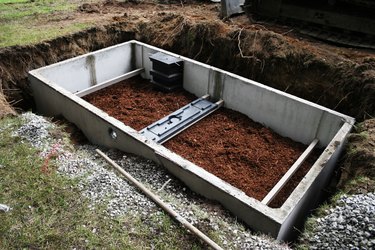
When you first think about it, you might conclude that a septic tank doesn't need a vent. After all, the bacteria that break down waste are anaerobic, which means they metabolize without oxygen, so why would they need a source of air? That's a good question, but you still need a septic tank vent, not to supply the bacteria with oxygen but to allow air in the tank to escape.
A plastic or concrete septic tank is an airtight container, and when it's empty, it's full of air. When you introduce water from the plumbing, the air has to go somewhere or else it would prevent the water from getting in. So, why don't you see a septic system vent pipe in the ground near a typical septic tank? That's because the venting is usually supplied by the building vents or vents installed in the drain field.
Video of the Day
Video of the Day
How a Septic System Works
The operation of a typical gravity-fed septic system is very simple. The tank is the repository for all the waste from the building's plumbing, and it has two openings: an inlet port from the building and an outlet to the drain field. This doesn't describe all systems because some tanks have pumps to transfer effluent to a drain field at a higher elevation, but most septic systems work like this.
When water enters through the 3- or 4-inch inlet, it passes by a baffle that forces all the solids to settle out, and the liquids continue to the 3- or 4-inch outlet, exit the tank, and go on to the drain field. The drain field is an area with fast-draining soil, and the drainage system consists of an array of a series of perforated pipes that distribute the water evenly so it can percolate into the soil. Not all drain fields are engineered this way, but most are because it's the simplest way to do it.
The Septic Tank Vent Is in the Building or the Drain Field
Both the inlet and outlet pipes of a septic tank are large enough to allow air and water to pass at the same time, so when air has to get out, it can flow through either pipe. When it flows back toward the building, it can escape through the building's plumbing vents, which are located on the roof. The building vents often provide enough venting for the tank, but as insurance, septic installers often provide vents in the drain field as well.
If you have a septic system, this should solve the mystery of why you see one or more pipes sticking up out of the ground in the drain field. They aren't plumbing clean-outs, which is why they don't have screw-on caps to make them watertight. They might have caps, but underneath the caps there should be louvers or mesh that allows air to pass through. A typical drain field has two or more legs of perforated pipe, and there is usually a vent on each leg.
What to Do About Septic Smells
The air exiting the building's plumbing vents sometimes wafts toward the ground for a couple of reasons. The winds could be responsible, or overhanging foliage could prevent exhaust from dispersing and floating away. If this is a persistent problem, consider extending the vents higher than the minimum required by your local plumbing code. Most codes require vents to rise 2 feet above the roof line, but you can lengthen them to 5 feet or even more if you need to clear an overhanging branch.
Odors coming from drain field vents usually aren't much of a problem because the drain field is far from the house. However, if odors are a problem on windy days, consider erecting barriers on the leeward sides of the pipes to prevent the wind from picking up the exhaust and blowing it in your direction. The barriers can be as simple as pieces of plywood on stakes and should be a few inches away from the pipes to avoid inhibiting airflow from the pipes.